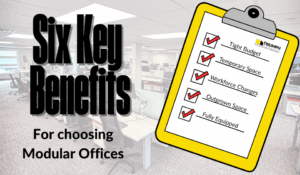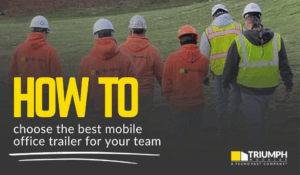Modular Buildings in Disaster Relief: Fast, Flexible, and Life-Saving Solutions
Disaster can strike at any moment. Preparedness is key for tackling any disaster head-on, whether it’s another pandemic or a natural disaster.
Disaster relief often comes with a need for more space or specialized buildings. In these moments, the nuances of the modular construction process are critical—especially when compared to traditional construction methods.
Below, we’ll highlight some of the benefits of modular construction for disaster relief, and some of the most common types of disasters that temporary buildings can help with.
What Makes Modular Buildings a Viable Option for Disaster Relief?
Modular Buildings Have Quick Setup Times
In times of crisis, things need to happen quickly. Governments want a solution as soon as possible, whether it’s temporary buildings for shelter or a portable classroom for a school.
Thankfully, speed to occupancy is one of the primary benefits of modular construction. From office trailers to premium modular buildings, modular construction offers quick turnaround times to provide the fastest possible disaster relief.
This quick turnaround time is a byproduct of the modular process—since most of the work is completed off-site, there’s no need for construction crews. Buildings need to be delivered and have a simple setup process once they arrive on-site.
Modular Construction Allows For Relocatable and Flexible Modular Buildings
Disaster relief presents many challenges—some of which may require flexible solutions.
Let’s use a natural disaster as an example. One area of a city may require attention for weeks, but what if another site needs more temporary shelter than initially planned? With modular solutions, buildings can relocate to get closer to the problem at hand.
The same can be said for a pandemic situation like COVID-19. Once the pandemic is over and testing labs are no longer needed, a temporary modular solution can either be returned or repurposed into another type of building, if necessary.
Unfortunately, traditional construction methods simply cannot offer this level of flexibility and relocation. Once a building goes up, it can’t be moved—it’s there for good.
Modular Building Cost Predictability
Modular isn’t always the cheapest option available. However, it provides far more cost predictability than traditional construction. This cost predictability is crucial in such tumultuous times.
The key to this cost predictability is keeping design changes to a minimum. We understand that it’s difficult to plan extensively for sudden disaster relief. with minimal design changes to the initial product, modular construction costs remain predictable and as low as possible. Keeping these costs low ensures that industries aren’t adding another issue to their existing list.
Modular Construction Can Be Less Affected by Weather
Natural disasters often mean inclement weather—the kind of weather that can pose a threat to traditional construction crews. In many cases, it can render traditional construction methods impossible to use.
Since most of the work involved with modular construction takes place in a controlled factory environment, modular construction methods avoid running into weather-related problems that can quickly halt disaster relief efforts.
Once the modular building process is complete, the building can be transported virtually anywhere—including remote locations.
Modular Buildings Work for Any Industry
One of the best parts about modular construction is that any industry can take advantage of it in times of crisis.
Although it’s most often used by industries like healthcare, education, and construction, we’ve seen some unique uses for different types of modular buildings, such as mobile office trailers.
Disaster relief presents one of the most unique use cases. Luckily, any industry in need of space due to a natural disaster or pandemic situation can take advantage of modular construction to mitigate losses and get through the disaster.
What Disasters Can Modular Construction Help With?
Disaster can strike at any time, and it can come in many different forms. Luckily, modular construction can help with many of these situations.
Some of these disaster situations include:
- Pandemics
- Tsunamis
- Hurricanes
- Tornados
- Wildfires
- Flooding
No matter the situation, modular can help. Companies often have various types of buildings at their disposal with different features, too.
Examples of Portable Buildings for Disaster Relief
Portable and temporary buildings are being used all around the country for disaster relief situations—to further illustrate our point, here are three examples covering three different types of relief.
Temporary Housing for Fire in Paradise, California
In 2018, the town of Paradise was ravaged by one of the worst wildfires in California’s history. Many were displaced from their homes, and a clean-up crew of over 1,500 people was called to help mitigate the damages.
As part of a relief effort, Black Diamond Group created temporary housing solutions for the town—two parallel strips of dorms with nearly 1,500 beds available. The rooms contained several crucial amenities, including:
- Air conditioning
- Wi-Fi
- Television
- Either private or Jack-and-Jill washroom facilities
The site also had two recreational facilities, a gym, a large kitchen, and a dining room.
The project’s first phase was up and running in just 68 days.
Temporary Buildings For Hurricane Ian
When Hurricane Ian hit in October 2022, thousands of individuals and businesses were affected—including Busey Bank. The hurricane breached the roof and destroyed the interior of their building, putting a halt to their operations.
As repairs were underway, Busey Bank needed a temporary solution to continue its operations unhindered. Modular construction gave them a solution with a quick turnaround time and little site disruption. In just three days, Boxx Modular shipped and installed a modular building with all of the amenities required by the bank: A 1,000 square foot building equipped with a deal drawer, drive-up window, phone system, depository, teller pedestals, and furniture.
Quick turnaround time on the temporary building helped Busey Bank resume operations during the repairs on their primary building.
Thayer Academy
Back in 2020, the COVID-19 pandemic forced many schools and education centers to rethink their spaces for social distancing—including Thayer Academy in Braintree, Massachusetts.
Together with Whitley Manufacturing, Triumph Modular provided Thayer Academy with additional classroom space to accommodate the new regulations. We created three new classrooms with the Silverline Building System that included all of the amenities found in their current buildings.
Modular construction allowed Thayer Academy to quickly occupy these buildings with minimal site disruption.
Preparation is Key For Disaster Relief
Navigating any kind of disaster starts with being prepared — from staff allocation to finances and beyond.
Triumph Modular’s Disaster Recovery Checklist removes the guesswork and ensures that you know what to do before, during, and after disaster strikes.
Download the Disaster Recovery Checklist today!






